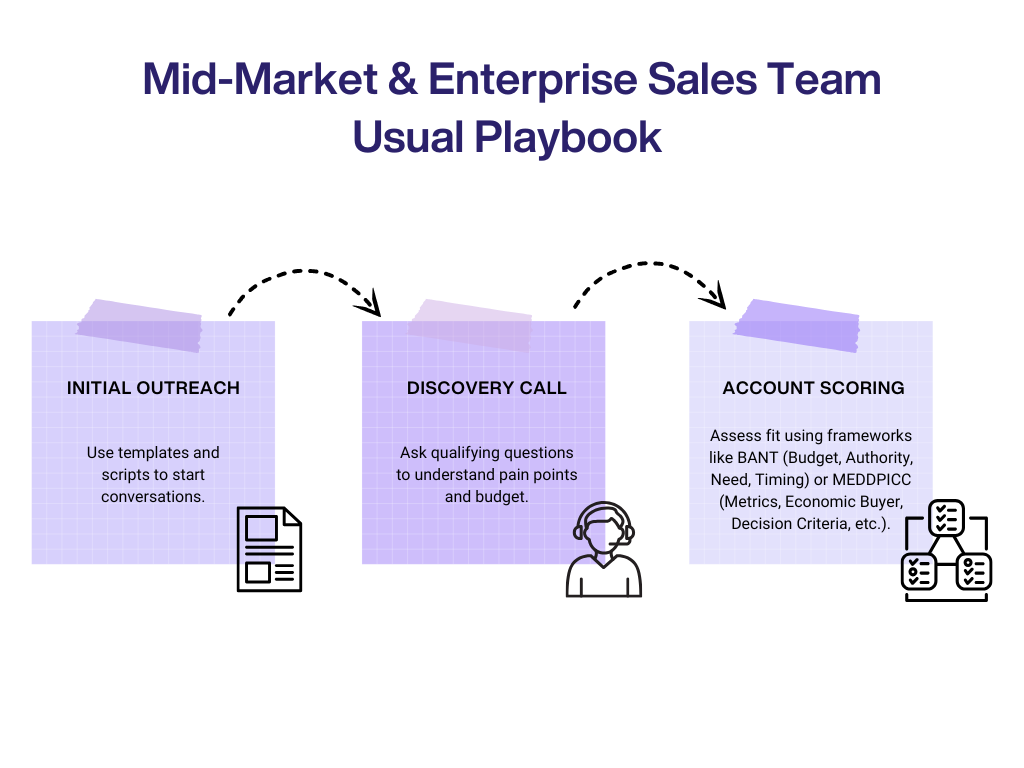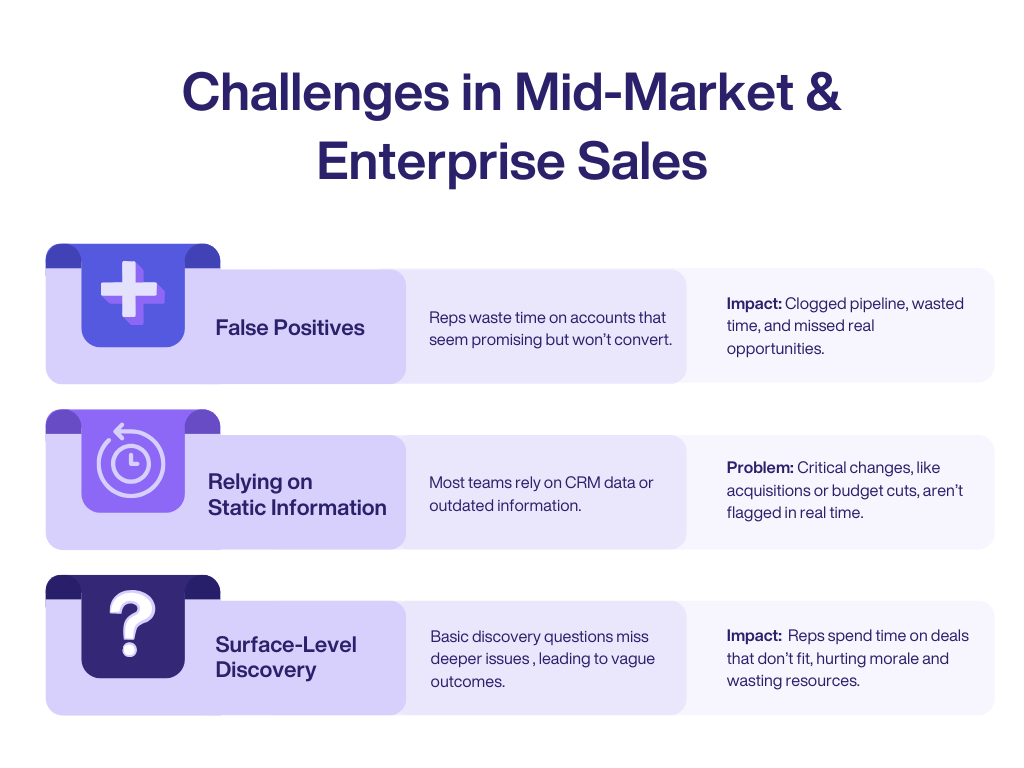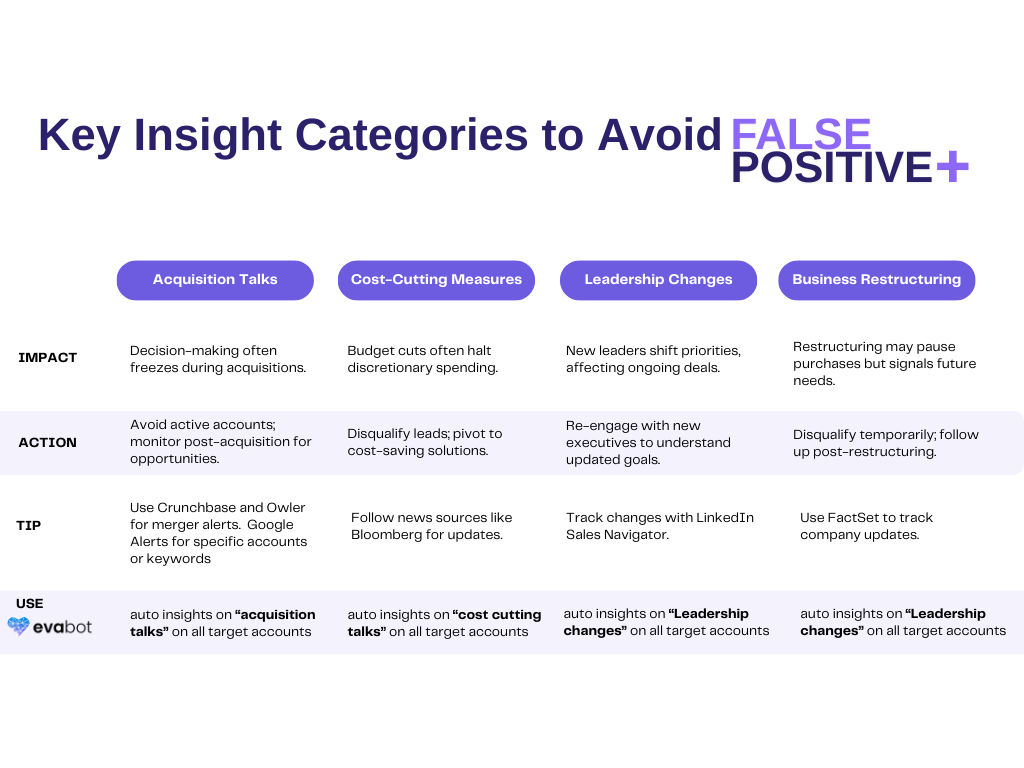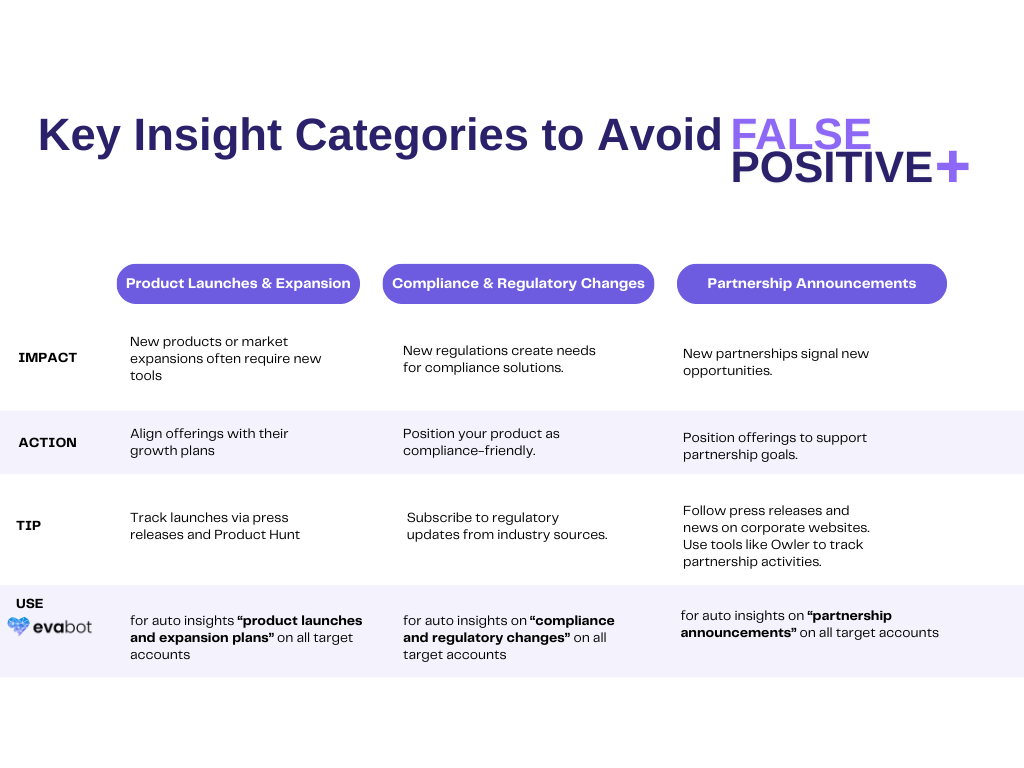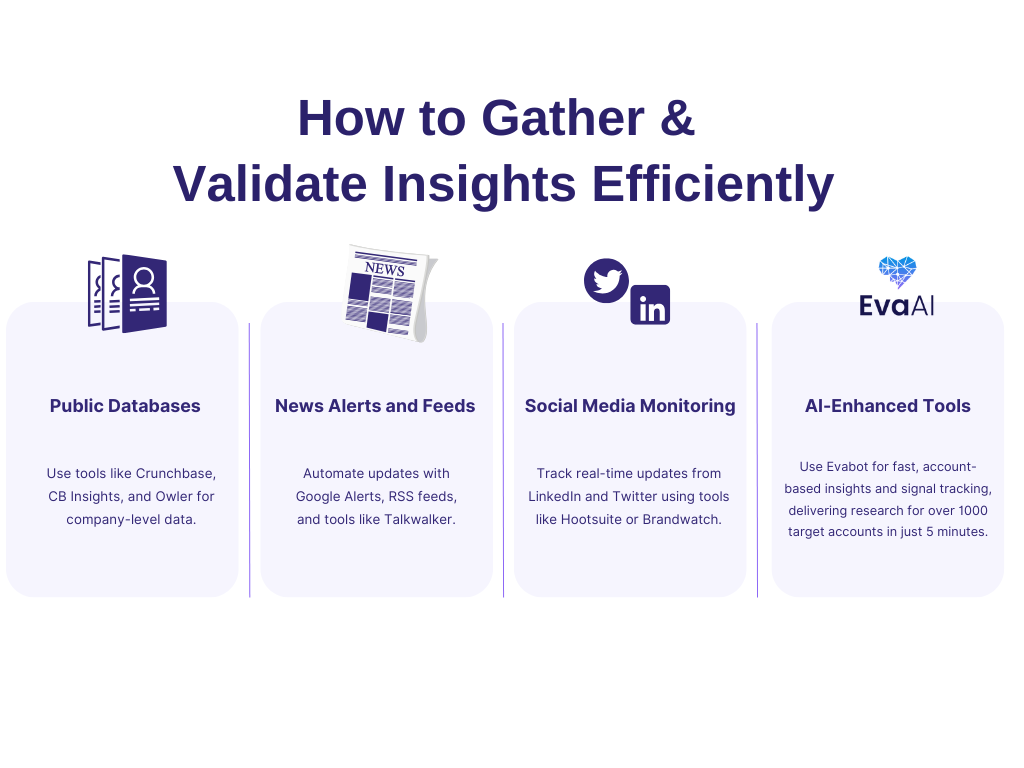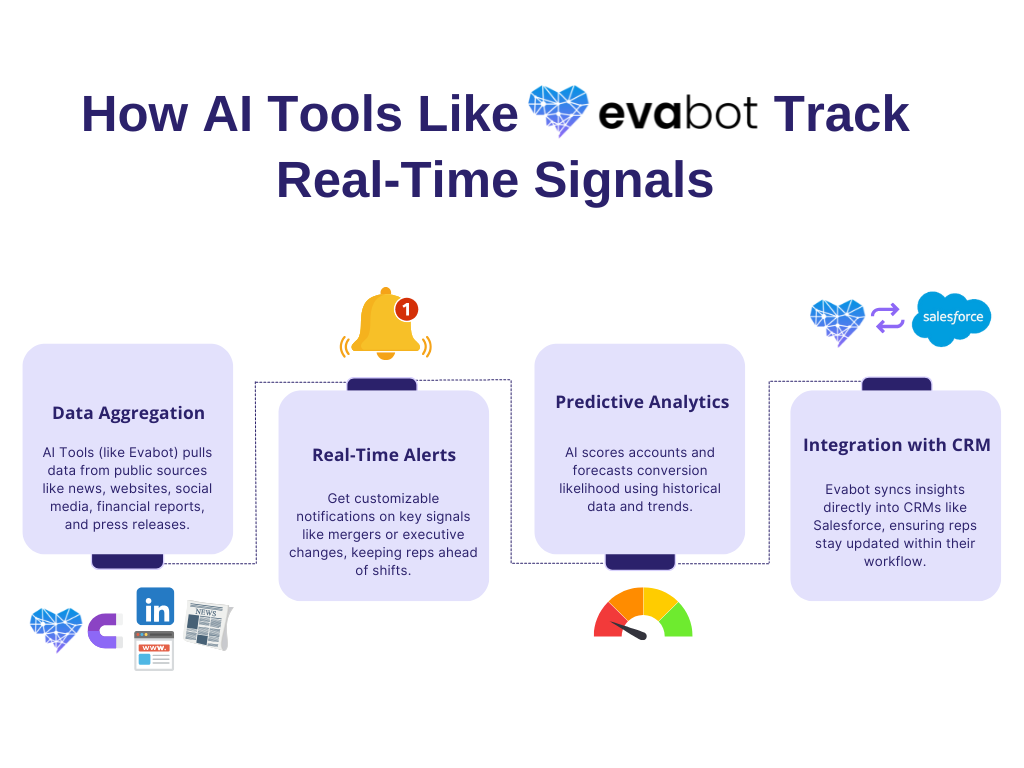Signal led Sales Discovery: Using Account Insights to Improve Conversion Rates
This newsletter explores how real-time account insights and signals transform sales discovery, enabling reps to filter false positives, prioritize high-potential leads, and improve conversion rates.
Hey, Welcome to this week’s edition of “Future of Prospecting” Newsletter by “Evabot”.
Webinar Alert (Before we start)
Register for our exclusive webinar “Cold Calling 2.0: How to Finish Q4 Strong” happening on 23 October 11 AM PT / 2 PM ET.
Sales discovery sets the foundation for every deal, but the way teams handle it today isn’t perfect.
Many mid-market and enterprise sales teams follow a familiar playbook:
Initial Outreach: Use templates and scripts to start conversations.
Discovery Call: Ask qualifying questions to understand pain points and budget.
Account Scoring: Assess fit using frameworks like BANT (Budget, Authority, Need, Timing) or MEDDPICC (Metrics, Economic Buyer, Decision Criteria, etc.).
These steps are useful but there are key struggles that sales teams face today:
1. False Positives
Reps waste time on accounts that seem promising but won’t convert.
Example: A company shows interest, but leadership changes derail decision-making mid-process.
Why It’s a Problem:
When teams overlook false positives, they clog the pipeline with non-convertible leads. This gives a false sense of progress and keeps reps from focusing on real opportunities.
2. Relying on Static Information
Most teams rely on CRM data or outdated information.
Problem: Critical changes, like acquisitions or budget cuts, aren’t flagged in real time.
Better Approach:
Use account insights tools that track real-time signals. Example: A sales rep detects layoffs at a prospect’s company and avoids wasting effort on a doomed deal.
3. Surface-Level Discovery
Discovery questions often scratch the surface, leading to vague outcomes.
Example: “Do you have a budget?” without knowing if the company is slashing budgets or restructuring.
How It Hurts:
Deals progress halfway before reps realize the fit isn’t there—time lost, morale hit.
Why are false positives so important to identify?
False positives are dangerous. Why? They create noise in the pipeline. Reps think they’re progressing when in reality, they’re just spinning wheels.
How It Impacts the Pipeline:
Time lost nurturing dead leads = fewer touches on high-potential ones.
Clogged pipeline = Misleading forecasts and missed targets.
The Fix: Catch False Positives Early
Sales teams need better account research tools that monitor real-time signals like:
Leadership changes that alter priorities.
Acquisition talks that freeze decisions.
Cost-cutting measures that halt new purchases.
By identifying false positives early, reps can disqualify them fast, leaving more room for meaningful conversations. Tools like Evabot can flag these signals and ensure your reps don’t chase ghost leads.
Next time a rep talks to an account, ask:
Have you identified recent signals?
Does anything hint at potential blockers?
These small tweaks can make all the difference in turning discovery into revenue.
Insight categories for Signal-Led Sales Discovery
The right insights can transform sales discovery from guesswork to precision. Below are key insight categories that help sales reps identify false positives early and focus on high-potential opportunities.
1. Acquisition Talks
When companies are in acquisition talks, decision-making is often frozen. Reps who miss this signal may waste time chasing deals that won't close soon.
How to Use:
Avoid active accounts where leadership focus shifts to integration.
Monitor post-acquisition periods, as they may signal new opportunities with refreshed budgets.
Tips for Manual Tracking:
Use tools like Crunchbase and Owler for merger alerts.
Set up Google Alerts for specific accounts or keywords (e.g., "Acquisition + [Company Name]").
PS - Use Evabot for auto insights on “acquisition talks” on all target accounts
2. Cost-Cutting Measures
Cost-cutting announcements are often a signal that companies are focusing on operational efficiency and may halt discretionary spending, including new software purchases.
How to Use:
Disqualify leads that announce budget cuts.
Pivot conversations toward cost-saving solutions if the account is still viable.
Tips for Manual Tracking:
Monitor news sources like Bloomberg or Reuters for layoffs or restructuring announcements.
Review annual reports and SEC filings for public companies, as they often highlight strategic shifts toward cost control.
PS - Use Evabot for auto insights on “cost cutting talks” on all target accounts
3. Leadership Changes
New executives often shift priorities, revisiting or canceling current projects. Deals pursued under old leadership may lose traction or change direction.
How to Use:
Reach out to new executives to understand updated priorities.
Use leadership changes as a reason to re-engage dormant accounts.
Tips for Manual Tracking:
Use platforms like LinkedIn Sales Navigator to track job changes.
Subscribe to company press releases or RSS feeds to stay updated on leadership news.
PS - Use Evabot for auto insights on “Leadership changes” on all target accounts
4. Business Restructuring or Strategic Shifts
Companies undergoing restructuring or strategic realignment may pause new purchases. However, these shifts can also indicate new future needs, such as cloud migration during IT overhauls.
How to Use:
Disqualify leads temporarily while restructuring efforts are ongoing.
Follow up later, as restructuring often introduces fresh opportunities.
Tips for Manual Tracking:
Monitor industry news sites and tools like FactSet for company updates.
Track changes in corporate strategy through earnings calls or analyst briefings.
PS - Use Evabot for auto insights on “business restructuring” on all target accounts
5. Product Launches and Expansion Plans
When a company is launching a new product or expanding into new markets, they may need tools, software, or services to support growth. This is a prime time for outreach.
How to Use:
Align offerings to support their launch goals or operations.
Offer pilot programs or short-term solutions during early stages of expansion.
Tips for Manual Tracking:
Use press releases, G2, or Product Hunt to track product announcements.
Monitor earnings calls for updates on future plans.
PS - Use Evabot for auto insights on “product launches and expansion plans” on all target accounts
6. Compliance and Regulatory Changes
Industries like finance, healthcare, and manufacturing often adjust strategies due to regulatory shifts. These changes can trigger new needs for compliance software or consulting services.
How to Use:
Position solutions as compliance-friendly to address their regulatory concerns.
Demonstrate how your offering mitigates risk under new regulations.
Tips for Manual Tracking:
Subscribe to regulatory updates from sources like the SEC or industry-specific news portals.
Follow compliance blogs and experts on LinkedIn.
PS - Use Evabot for auto insights on “compliance and regulatory changes” on all target accounts
7. Partnership Announcements
When companies form new partnerships, it often leads to new business models or operational requirements. This is a signal to explore collaboration opportunities.
How to Use:
Position your offering to complement the new partnership's goals.
Use partnerships as a reason to reconnect with inactive accounts.
Tips for Manual Tracking:
Follow press releases and news on corporate websites.
Use tools like Owler to track partnership activities.
PS - Use Evabot for auto insights on “partnership announcements” on all target accounts
How to Gather and Validate Insights Efficiently
Sales reps need a reliable process to track and validate these signals:
Public Databases: Use sources like Crunchbase, CB Insights, and Owler for company-level data.
News Alerts and Feeds: Automate updates with Google Alerts, RSS feeds, and tools like Talkwalker.
Social Media Monitoring: Track real-time updates from LinkedIn and Twitter using tools like Hootsuite or Brandwatch.
AI-Enhanced Tools: Use Evabot that offer account-based insights and signal tracking at lightning speed (i.e 5 minutes to get all research for more than 1000 target accounts).
Many sales teams rely too heavily on static CRM data. But deals are dynamic—relying only on outdated info is risky. Teams need real-time tools to capture fast-changing signals. Integrating AI-powered platforms like Evabot ensures that sales teams stay ahead, focusing only on the most promising opportunities.
Teams that adopt real-time tools and automate their insight tracking can stay ahead in competitive markets. Using platforms like Evabot and LinkedIn Sales Navigator ensures that reps engage with the right accounts at the right time.
These small but essential tweaks to the discovery process help sales teams focus on opportunities that are most likely to convert, driving both efficiency and win rates.
How AI Transforms Signal-Led Discovery with Real-Time Insights
AI is changing how sales teams discover and engage with accounts.
Traditional discovery methods rely heavily on manual research, but AI tools like Evabot streamline this process, tracking signals across multiple categories such as acquisitions, leadership changes, cost-cutting, market shifts and many more as per your context.
How AI Tools Like Evabot Track Real-Time Signals
AI tools operate by aggregating and analyzing data across multiple channels to provide actionable insights. Here’s how they work:
Data Aggregation: AI Tools (like Evabot) pulls data from public sources like news websites, social media, financial reports, and press releases.
Real-Time Alerts: It delivers high priority insights and notifications for key signals (which you can customize) such as mergers, layoffs, or executive changes. It keeps reps ahead of shifting priorities.
Predictive Analytics: AI scores the target accounts and forecasts the likelihood of account conversion based on historical data, trends, and signals (like market expansion or compliance needs).
Integration with CRM: Evabot syncs insights directly into CRMs like Salesforce. It ensures reps see the latest updates within their workflow.
Where AI Fits into the Sales Workflow: A Process Map
Pre-Call Research
AI tools scan for recent signals (e.g., acquisition rumors or executive hires).
Reps receive real-time insights before meetings to tailor conversations.
Discovery Calls
Reps validate AI-driven insights by asking targeted questions.
Example: "I noticed your company recently announced cost-cutting measures. How is that affecting your priorities?"
Account Qualification
AI flags potential false positives early—saving time by disqualifying unready leads.
Example: Avoiding accounts in acquisition phases where buying decisions are on hold.
Pipeline Management
Insights help reps prioritize high-potential accounts.
The CRM updates in real time with fresh signals, preventing reps from chasing dead leads.
Evabot vs. Traditional Research: Why AI Wins
Traditional sales research methods involve manual data collection, which is time-consuming and prone to outdated information.
Evabot’s AI-powered insights solve some of the biggest challenges in discovery. With real-time signals, reps can avoid the common pitfalls of traditional research:
Fewer False Positives: AI identifies blockers early (e.g., leadership turnover), allowing reps to focus on high-value accounts.
Shorter Sales Cycles: Real-time alerts keep deals moving by informing the next steps.
Improved Conversion Rates: By tailoring outreach with the right insights, reps engage more effectively with prospects.
AI tools are the future of sales discovery, saving time, boosting accuracy, and driving better outcomes. For teams that embrace signal-led discovery, the result is a streamlined process, fewer dead leads, and higher win rates.
Quantify the Impact on Pipeline and Conversions
Sales is all about focus. When reps spend too much time on dead-end accounts, the entire pipeline suffers. Shifting efforts from unqualified accounts to high-potential ones is the key to driving better outcomes. Here’s how that plays out in practice.
The Scenario: Identifying False Positives Early
Let’s say a sales rep is managing three active accounts:
Account A: Recently acquired and in transition—unlikely to buy soon.
Account B: Announced layoffs—focusing on internal efficiency, not new investments.
Account C: Actively expanding into new markets and seeking operational tools.
In the past, the rep might have spent equal time on all three. But with signal-led insights, they quickly identify Accounts A and B as false positives and shift focus to Account C.
Result:
The rep avoids wasted time on two non-converting leads.
Effort shifts to Account C, increasing chances of closing a meaningful deal.
Pipeline Impact: Measurable Outcomes
1. Increased Win Rate
The rep spends more time on accounts that are likely to convert.
Example: Shifting focus improves the win rate from 25% to 35%.
2. Shorter Sales Cycle
Fewer dead leads = more time for meaningful conversations.
Metric: The average sales cycle drops from 90 to 70 days.
3. Improved Forecast Accuracy
With fewer false positives, pipeline estimates become more reliable.
Leaders can forecast sales outcomes with greater precision.
The Bigger Picture: How It Adds Up
Imagine if every rep on a 10-person team removes just two dead leads a month from their pipeline.
Time saved: 20+ hours per month.
Deals closed: Focusing on better accounts adds 1-2 more deals per quarter per rep.
Revenue impact: With an average deal size of $50,000, that’s an extra $500,000 in closed business per quarter for the team.
KPIs to Track Signal-Led Discovery Success
To ensure reps are using insights effectively, here are the KPIs every sales team should monitor:
Win Rate: Tracks how often deals are successfully closed.
Sales Cycle Length: Measures the time from first contact to closure.
Pipeline Velocity: The speed at which deals move through the pipeline.
Lead Qualification Rate: Percentage of leads correctly identified as high-potential.
Forecast Accuracy: How close the predicted revenue aligns with actual results.
It’s easy to get excited about removing false positives, but the key lies in balance. Reps still need to explore gray areas—accounts that aren’t an immediate fit but may develop into opportunities later.
Sales leaders should emphasize continuous learning. Encourage reps to review lost deals and identify missed signals. This feedback loop ensures the discovery process gets sharper over time, improving both the quality and velocity of the pipeline.
When sales reps make smarter decisions based on signals, pipeline health improves—and so does the bottom line.
Key Takeaways and Best Practices for Signal-Led Sales Discovery
Sales discovery is evolving. Using account insights to drive discovery ensures better outcomes, faster cycles, and fewer wasted efforts. But to get it right, sales teams need a structured approach.
Best Practices for Using Account Insights Effectively
1. Make Pre-Call Research a Habit
Always gather key signals like leadership changes or cost-cutting announcements before engaging with prospects.
2. Validate Insights During Conversations
Don’t rely solely on automated data—confirm signals with open-ended questions.
Example: “I noticed your company is expanding. How has that affected your immediate needs?”
3. Focus on Pipeline Quality, Not Just Quantity
Shift the focus from more leads to better leads. Train reps to filter accounts quickly based on insights.
Example: If a company is under acquisition, pause outreach and revisit later.
4. Incorporate Signal-Tracking into Team KPIs
Track KPIs like lead qualification rate and sales cycle length to measure how effectively reps use insights.
Recommendations for Sales Leaders: Build a Signal-Led Culture
Create Playbooks for gathering and using account insights during discovery calls.
Reward Insight-Driven Behavior: Highlight and reward reps who successfully apply insights to close deals.
Encourage Continuous Learning: Regularly review deals to spot missed signals and improve future efforts.
Integrate AI Tools Seamlessly: Ensure AI tools like Evabot work smoothly within the team’s daily workflow.
By following these best practices, sales teams can unlock the full potential of signal-led discovery. Leaders who foster a data-driven culture will see faster sales cycles, higher win rates, and more accurate forecasting. With tools like Evabot, reps stay ahead of shifting signals and spend their time where it matters most—closing deals.
Would you like to evaluate “Evabot AI” for signal led discovery? Book a meeting on the button below.
If you’re not a subscriber, here’s what you missed earlier:
Subscribe to get access to our weekly posts on Prospecting, Automation, AI, Revenue Growth and Lead Generation.



